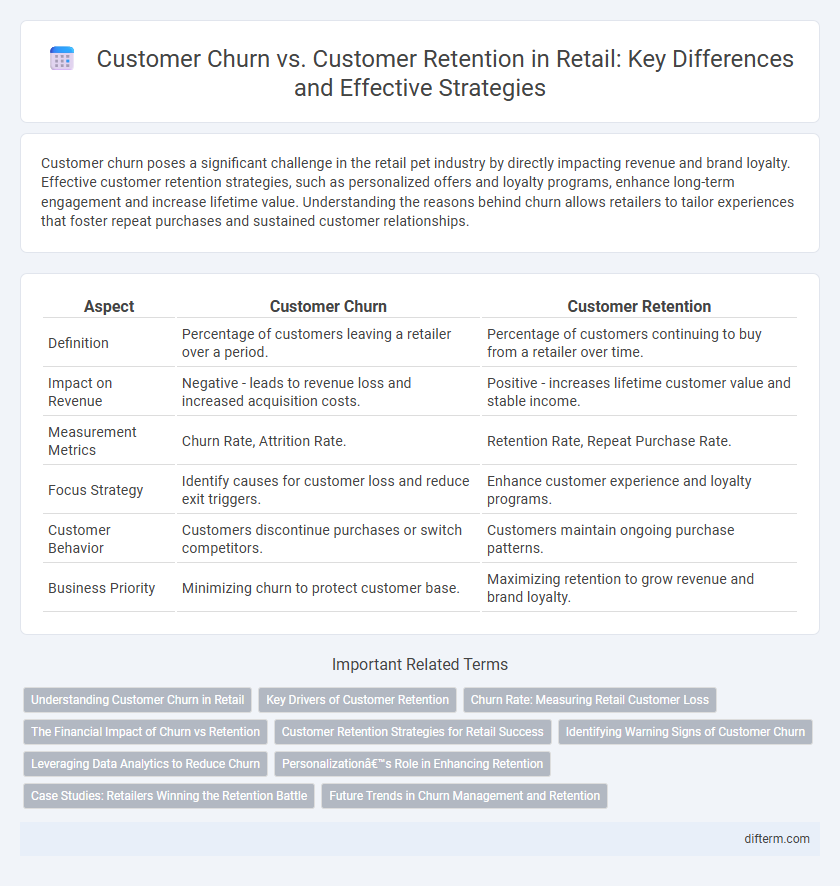Customer churn poses a significant challenge in the retail pet industry by directly impacting revenue and brand loyalty. Effective customer retention strategies, such as personalized offers and loyalty programs, enhance long-term engagement and increase lifetime value. Understanding the reasons behind churn allows retailers to tailor experiences that foster repeat purchases and sustained customer relationships.
Table of Comparison
| Aspect | Customer Churn | Customer Retention |
|---|---|---|
| Definition | Percentage of customers leaving a retailer over a period. | Percentage of customers continuing to buy from a retailer over time. |
| Impact on Revenue | Negative - leads to revenue loss and increased acquisition costs. | Positive - increases lifetime customer value and stable income. |
| Measurement Metrics | Churn Rate, Attrition Rate. | Retention Rate, Repeat Purchase Rate. |
| Focus Strategy | Identify causes for customer loss and reduce exit triggers. | Enhance customer experience and loyalty programs. |
| Customer Behavior | Customers discontinue purchases or switch competitors. | Customers maintain ongoing purchase patterns. |
| Business Priority | Minimizing churn to protect customer base. | Maximizing retention to grow revenue and brand loyalty. |
Understanding Customer Churn in Retail
Customer churn in retail refers to the rate at which customers stop purchasing from a brand or store over a specific period, directly impacting revenue and market share. Analyzing customer churn involves examining purchase frequency, customer satisfaction scores, and competitive offers to identify patterns triggering lost loyalty. Effective churn prediction models leverage transactional data and behavioral insights to enable targeted retention strategies that improve customer lifetime value and reduce attrition rates.
Key Drivers of Customer Retention
Customer retention in retail is driven by factors such as personalized customer experiences, reliable product quality, and effective loyalty programs. Data shows that consistent customer engagement and seamless omnichannel support significantly reduce churn rates, increasing lifetime customer value. Prioritizing trust-building initiatives and feedback mechanisms leads to higher retention, ultimately boosting sales growth and competitive advantage.
Churn Rate: Measuring Retail Customer Loss
Churn rate quantifies the percentage of customers a retail business loses over a specific period, serving as a critical metric for assessing customer attrition. Accurate measurement of churn rate involves analyzing transaction frequency, purchase recency, and customer engagement patterns to identify at-risk customer segments. Reducing churn rate directly impacts revenue stability by maintaining a loyal customer base and optimizing marketing efforts towards retention strategies.
The Financial Impact of Churn vs Retention
Customer churn significantly increases operational costs by necessitating additional marketing expenses to acquire new customers, while retention strategies enhance lifetime customer value and revenue predictability. Research indicates that increasing retention rates by 5% can boost profits by 25% to 95%, emphasizing its critical role in financial performance. Effective retention reduces churn-related losses, stabilizes cash flow, and optimizes return on investment in customer relationship management.
Customer Retention Strategies for Retail Success
Effective customer retention strategies significantly boost retail success by enhancing brand loyalty and increasing customer lifetime value. Personalization through targeted promotions, loyalty programs, and excellent customer service drives repeat purchases and reduces churn rates. Leveraging data analytics to understand consumer behavior allows retailers to tailor experiences that foster long-term engagement and sustainable growth.
Identifying Warning Signs of Customer Churn
Identifying warning signs of customer churn involves analyzing behavioral metrics such as decreased purchase frequency, reduced engagement with marketing channels, and negative feedback or complaints. Monitoring customer interaction patterns and satisfaction scores enables retailers to proactively address issues before customers leave. Early detection through data analytics improves retention strategies, increasing long-term customer lifetime value and revenue stability.
Leveraging Data Analytics to Reduce Churn
Leveraging data analytics enables retailers to identify patterns and behaviors that predict customer churn, allowing for timely and personalized interventions. Advanced algorithms analyze purchase history, engagement metrics, and demographic data to segment high-risk customers and tailor retention strategies effectively. Data-driven insights enhance customer lifetime value by optimizing loyalty programs and improving overall customer experience to reduce churn rates.
Personalization’s Role in Enhancing Retention
Personalization significantly boosts customer retention by delivering tailored shopping experiences that meet individual preferences and needs, reducing the risk of churn. Customized recommendations, targeted promotions, and personalized communications foster stronger customer loyalty and engagement in the retail sector. Leveraging data analytics and AI-driven insights enables retailers to anticipate customer behavior, enhancing retention rates and decreasing churn effectively.
Case Studies: Retailers Winning the Retention Battle
Retailers like Amazon and Starbucks have demonstrated that personalized loyalty programs and data-driven insights significantly reduce customer churn while boosting retention rates. Case studies reveal that leveraging AI-powered recommendation engines and real-time engagement strategies increases repeat purchase frequency, directly impacting lifetime customer value. Implementing omnichannel communication and seamless customer experiences secures competitive advantages in the retail industry by consistently winning the retention battle.
Future Trends in Churn Management and Retention
Emerging trends in retail churn management emphasize predictive analytics and AI-driven personalization to anticipate customer behavior and tailor retention strategies. Increasing integration of omnichannel data enables retailers to create seamless experiences that reduce churn risk by addressing customer needs proactively. Enhanced loyalty programs leveraging real-time insights drive sustained engagement, transforming retention efforts into dynamic, data-powered processes.
Customer Churn vs Customer Retention Infographic

 difterm.com
difterm.com